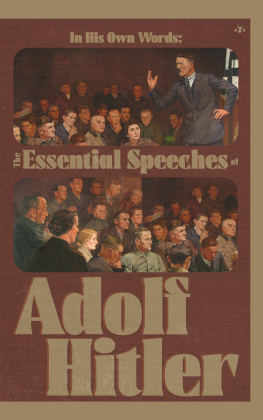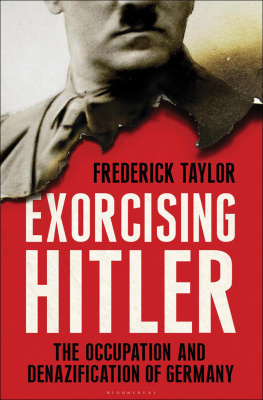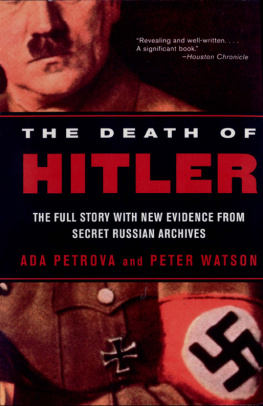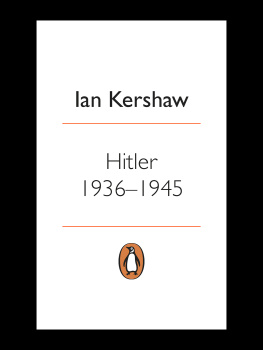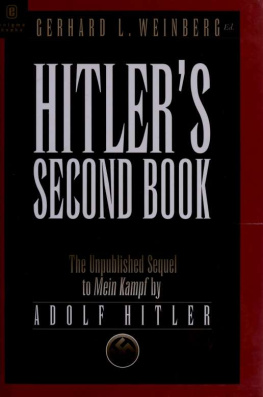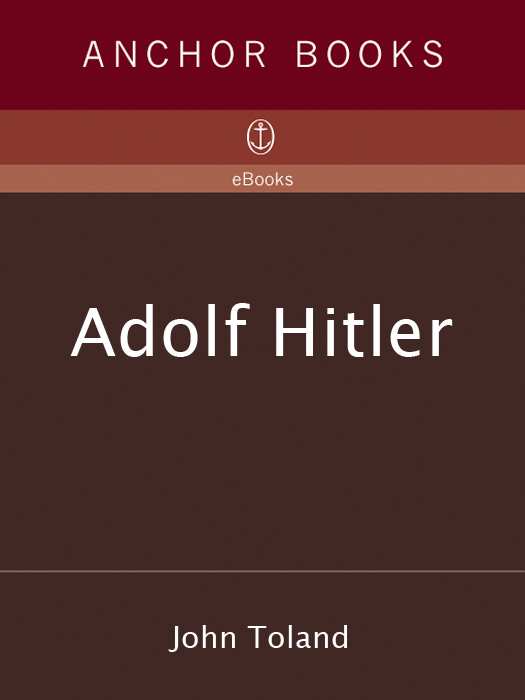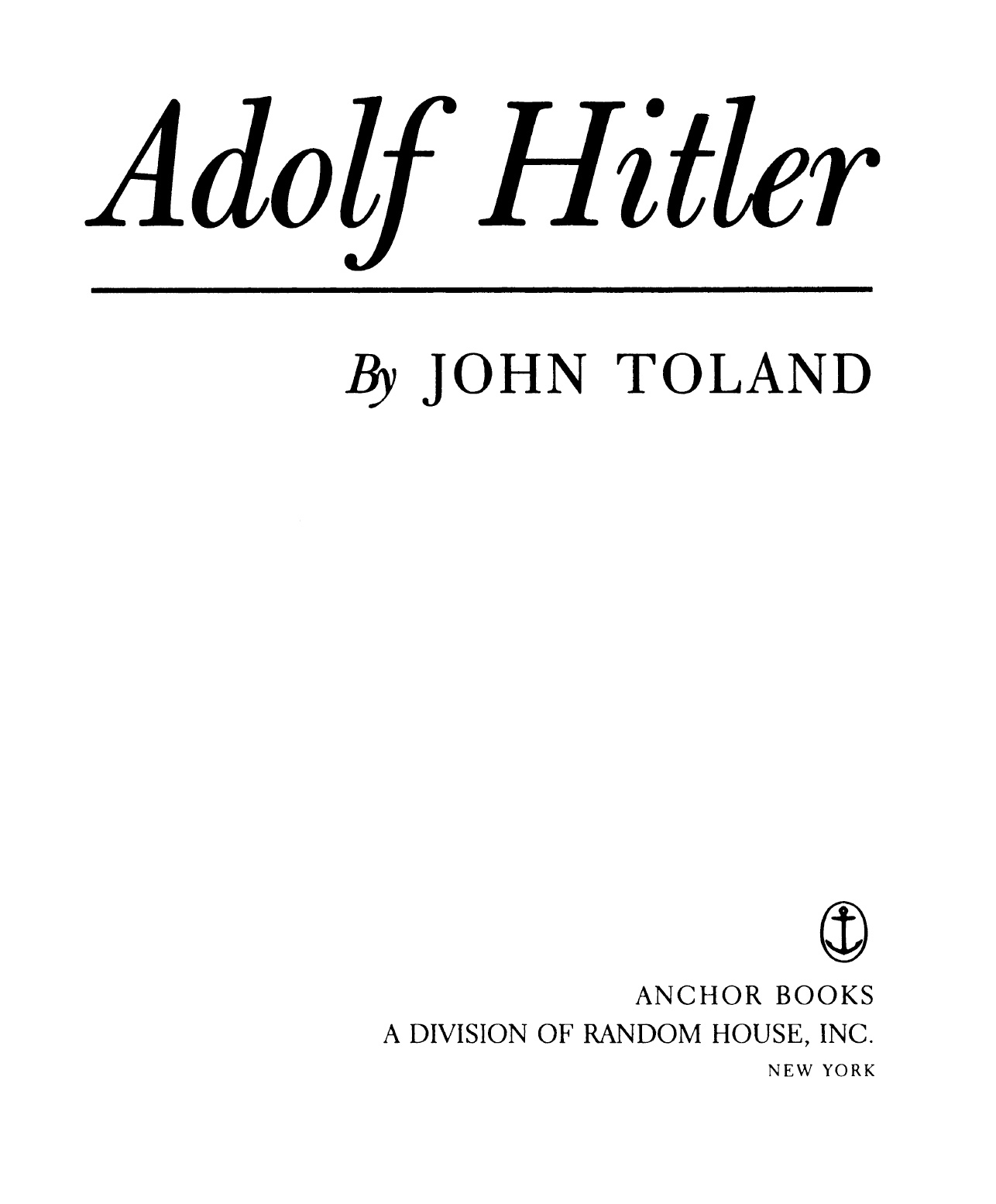F IRST A NCHOR B OOKS E DITION , J ANUARY 1992
Copyright 1976 by John Toland
All rights reserved under International and Pan-American Copyright Conventions. Published in the United States by Anchor Books, a division of Random House, Inc., New York, and simultaneously in Canada by Random House of Canada Limited, Toronto. Originally published in hardcover in the United States by Doubleday, a division of Random House, Inc., in 1976.
A NCHOR B OOKS and colophon are registered trademarks of Random House, Inc.
Grateful acknowledgment is made for permission to quote portions from the following:
The Young Hitler I Knew by August Kubizek. Copyright 1954 by Paul Popper and Company. Reprinted by permission of the publisher, Houghton Mifflin Company, Boston.
Hitlers Secret Conversations, 19411944, edited by H. R. Trevor-Roper, translated by Norman Cameron and R. H. Stevens. Copyright 1953 by Farrar, Straus and Young, Inc. Reprinted with the permission of Farrar, Straus & Giroux, Inc., and of George Weidenfeld & Nicolson Ltd., London.
The Testament of Adolf Hitler: The Hitler-Bormann Documents, FebruaryApril 1945, edited by Franois Genoud and translated by R. H. Stevens. Copyright 1959, Libraire Arthme Fayard; English edition published by Cassell & Co., Ltd. Reprinted by permission of A. D. Peters & Co., Ltd.
Hitlers Interpreter by Paul Schmidt. Copyright 1951 by Opera Mundi, Inc. Reprinted by permission of Opera Mundi, Inc.
Douze ans auprs dHitler: Confidences dune secrtaire particulire dHitler, recorded by Albert Zoller. Copyright 1949 by Editions Ren Julliard. Reprinted by permission of Editions Ren Julliard.
Library of Congress Cataloging-in-Publication Data
Toland, John.
Adolf Hitler / by John Toland.
p. cm.
Originally published: Garden City, N.Y.: Doubleday, 1976.
Includes bibliographical references (p. ) and index.
1. Hitler, Adolf, 18891945. 2. Heads of stateGermany
Biography. 3. GermanyHistory19331945. I. Title.
DD247.H5T56 1992 91-31242
943.086092dc20 CIP
[B]
ISBN 0-385-42053-6
eBook ISBN: 978-1-101-87277-2
Trade Paperback ISBN: 978-0-385-42053-2
www.anchorbooks.com
v3.1
Contents
List of Maps & Tables
Foreword
Adolf Hitler was probably the greatest mover and shaker of the twentieth century. Certainly no other human disrupted so many lives in our times or stirred so much hatred. He also inspired widespread adoration and was the hope and ideal of millions. The passage of more than thirty years since his end has done little to alter the perspective of either enemies or true believers. Today we see the other leaders of his eraRoosevelt, Churchill, Mussolini, Stalinin a different, more objective light but the image of Hitler has remained essentially the same. To the few who remained his faithful followers he is a hero, a fallen Messiah; to the rest he is still a madman, a political and military bungler, an evil murderer beyond redemption whose successes were reached by criminal means.
As one of those whose life was altered by Hitler, I have done my utmost to subdue my own feelings and to write of him as if he had lived a hundred years ago. I interviewed as many as possible of those who knew Hitler intimatelyboth worshipers and deriders. Many agreed to talk freely and at length about the unhappy past. Gone was the reluctance of past years to discuss the Fhrer and his actions for fear their views might be distorted. I conducted more than two hundred and fifty interviews with his adjutants (Puttkamer, Below, Engel, Gnsche, Wnsche and Schulze); his secretaries (Traudl Junge and Gerda Christian); his chauffeur (Kempka); his pilot (Baur); his doctors (Giesing and Hasselbach); his favorite warriors (Skorzeny and Rudel); his favorite architects (Speer and Giesler); his first foreign press secretary (Hanfstaengl); his military leaders (Manstein, Milch, Dnitz, Manteuffel and Warlimont); the women he most admired (Leni Riefenstahl, Frau Professor Troost and Helene Hanfstaengl). All but a dozen of these interviews were recorded on tapes which presently are stored in the Library of Congress for safekeeping. All those interviewed whose accounts are included in the book read the passages about themselves and not only made corrections but often added illuminating comments.
Significant new documents, reports and studies have also been utilized to help unravel the mystery of Hitler: the dossiers of the U. S. Army Counter-Intelligence Command, including one agents interview with Hitlers sister Paula; unpublished documents in the National Archives such as a secret psychiatric report on Hitler in 1918; the unpublished documents from the British Government Archives; the recently discovered Gring-Negrelli correspondence of 192425 which sheds new light on Nazi-Fascist relations; the secret speeches of Himmler; and unpublished diaries, notes and memoirs including the revealing recollections of Traudl Junge, Hitlers youngest secretary.
My book has no thesis, and any conclusions to be found in it were reached only during the writing, perhaps the most meaningful being that Hitler was far more complex and contradictory than I had imagined. The greatest saints, observed one of Graham Greenes characters, have been men with more than a normal capacity for evil, and the most vicious men have sometimes narrowly evaded sanctity. Deprived of heaven, Adolf Hitler chose hellif, indeed, he knew the difference between the two. To the end, obsessed by his dream of cleansing Europe of Jews, he remained a Knight of the Hakenkreuz, a warped archangel, a hybrid of Prometheus and Lucifer.
Prologue
STAB IN THE BACK
1
In mid-October 1918 a hospital train, the sides of its carriages defaced by revolutionary slogans, slowly wended its way through Germany toward the secure eastern marches of the Empire. Among the hundreds of casualties on the train were blinded victims of a recent poison gas attack in Belgium. It had followed a devastating British artillery assault on the night of the thirteenth, one of a relentless series of hammer blows that the German front, retreating, bending but not breaking, had sustained since the battle turned so decisively three months earlier. The 16th Bavarian Reserve Infantry Regiment, which took the brunt of the attack, was dug in on hills and fields, a spectral battleground churned into a morass of craters. The men, physically exhausted, and dispirited as much by ugly rumors of mutinies along the front as by the unceasing Allied attacks, huddled in trenches while British shells tore up the ground around them. The veterans were numbed, the recruits terrified.
Suddenly, thuds mingled with the explosions and a pungent cloud drifted into the trenches. Someone shouted, Gas! It was their first experience with mustard gas. To some it smelled sweet, to others acrid; in every case it clung tenaciously to the nostrils. The men slapped on their masks, then hunched, inanimate, against the sides of the trenches. Hours passed. The air inside the masks became dense and stale. One of the recruits, driven half mad by suffocation, wrenched the mask from his face only to gulp in the deadly poison. It caught him by the throat and flung him back choking, gurgling, suffocating, dying.



